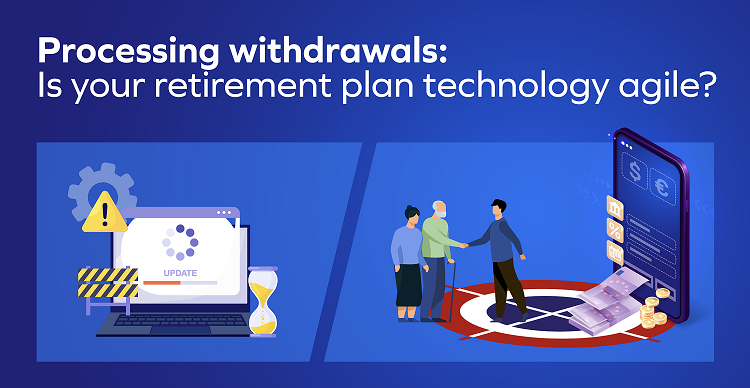
For years, laws discouraged early 401(k) withdrawals. For anyone withdrawing before their retirement age, there were penalties and tax implications. And then COVID struck. The disruption led the federal government to loosen restrictions for withdrawals from retirement savings. The Coronavirus Aid, Relief, and Economic Security (CARES) Act allowed users to withdraw up to $100,000 without penalty until 31 December 2020.
While it is another story that there was not really a barrage of withdrawals from retirement savings among Americans, for plan providers, administrators, and recordkeepers, this was a wake-up call. It made clear that not only can laws change unexpectedly, but they might not get months to implement these changes either.
In the future, as the world adapts to post-pandemic realities, retirement plan providers need to adapt their systems instantly, update their technology, and start processing withdrawals immediately.
Is your technology foundation ready for that? More often than not, the answer is no. Here’s why:
Legacy systems: Plan providers, administrators, and recordkeepers are working off legacy mainframe systems in which business logic and code are tightly intertwined. To make the slightest change in a business rule — say, updating the penalty-free withdrawal limit — these systems require qualified mainframe developers. This can be both expensive and time-consuming. To say nothing of the talent shortage in legacy technologies.
Manual processes: To this day, much of withdrawals processing is performed manually. Given plan providers and administrators design their staffing strategy for the steady-state, the teams can get overwhelmed when there is a sudden spike in requests. This is also compounded by the need for remote work, which legacy technologies can barely enable.
As we go into a future where customer expectations are high, the market situation is volatile, and compliance restrictions are tight, enterprise resilience can only come from agility. All stakeholders in the retirement plan industry need technology foundations that enable that.
Decouple business logic and code
For starters, you need solutions that decouple business logic and code. Your programs should be agile enough to allow business teams to edit business logic as per their needs without getting the IT involved. This itself will bring significant agility to the process.
Embrace automation
You need to integrate automation into their processes. A good place to start might be rule-based automation or robotic process automation, which mimics human behavior and performs tasks at scale. However, to gain maximum value from automation, your need to create a roadmap towards artificial intelligence-driven autonomous decision-making.
Re-architect your solutions
Even after decoupling business logic and code, legacy systems aren’t the most agile technologies out there. Enterprises need to begin investing in microservices-based applications, cloud implementations, etc., that imbibe a layer of agility to the technology itself. It also helps to modernize the front-end of the applications to be more user-friendly, paving the way for self-service platforms in the future.
Get a reliable operations partner
Outsourcing to a reliable, experienced partner can help ease your existing staff off the burdens of everyday document processing. Whether you need them for daily processing or taking on 401k plan compliance testing, year-end forms preparation, etc., building an ongoing relationship with a partner will help make processing seamless, never overwhelming your systems or your people.
Focus on long-term value
As margins shrink in the retirement plan industry, plan providers, administrators, and recordkeepers need to innovate to survive. This can only come from digital transformation, adding value to plan sponsors and participants alike. With self-service platforms, personalized recommendations, analytics dashboards, periodic reminders, behavioral triggers, educational communication, robo-advisors, etc., you must explore a wider array of services to enlarge the pie instead of scraping the leftovers.
While COVID-19 and the CARES Act focused on withdrawals as the critical change, it is not the only one possible. Other implications like taxation, penalty, rollover, etc., are also likely to change periodically. To have reliable, secure, and agile technology solutions is the most crucial competitive advantage. For now and for the future.
